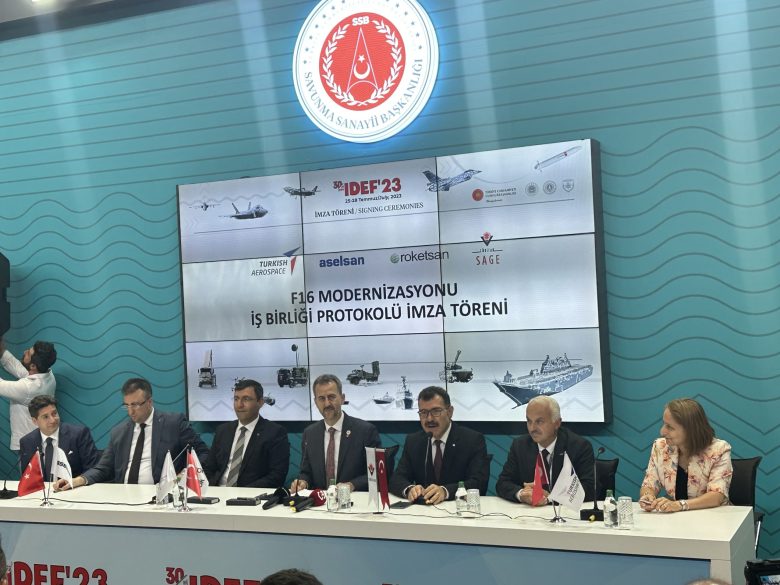Turkish Aerospace, Aselsan ink $2B in deals to upgrade F-16 jets
Turkish Aerospace Industries has signed two contracts worth nearly $2 billion with the country’s largest defense company to upgrade F-16 fighter jets.
The deals announced by Aselsan, a military electronics specialist, were for $1.2 billion and 20.7 billion liras (U.S. $789.2 million).
The Biden administration has backed Turkey’s desire to buy 40 new F-16s as well as modernization kits from the U.S. It’s a move some in Congress, most notably Senate Foreign Relations Committee Chairman Bob Menendez, D-N.J, have opposed over Turkey blocking NATO membership for Sweden, its human rights record, its relations with Greece and other concerns.
Neither TAI nor Aselsan revealed details of the contracts, inked July 13. But a government procurement official and sources with the businesses told Defense News that the contracts are related to a program to upgrade Turkey’s aging F-16s, starting with the Block 30 level.
The upgrade program will include a new mission computer, an active electronically scanned array radar and new avionic suites for about 150 Turkish F-16 aircraft. The program will also include new cockpit color displays, a new indigenous identification friend or foe system, a new system interface unit, a hydraulic fuel gauge, new radar warning receivers, and an inertial navigation system.
The backbone of the upgrade program is a subsystem dubbed Ozgur (”free” in English) that aims to develop and produce Turkey’s first AESA radar, which Aselsan officials hope will extend the flight time for some of the country’s F-16 aircraft by half, to 12,000 hours.
Per upgrade plans, the AESA radar will first be retrofitted onto the Akinci, a drone built by TAI; then on a batch of 36 F-16 Block 30 aircraft; and, in the longer term, the TF-X, Turkey’s first indigenous fighter jet in the making. Block 30 is the only F-16 model whose source codes are available to Turkey.
“This deal has two implications: One, it is part of Turkish efforts to balance Greece’s increasing air superiority over the Aegean Sea, especially by buying new French-made Rafales; and two, once [the upgrade is successful and the aircraft is] combat proven, it may pave the way for Aselsan and TAI to penetrate into the world’s large F-16 modernization market,” said Ozgur Eksi, who runs the media outlet TurDef.
In 2019, Turkey requested the Link 16 tactical data link, among other technology, for 199 F-16 jets. Then, acording to January 2023 media reports, the Biden administration “informally notified Congress of its intent to sell 40 new F-16s in the Block 70/72 Viper configuration (F-16Vs) and Viper upgrade packages for 79 existing fighters, along with 900 air-to-air missiles and 800 bombs, at an estimated total value of $20 billion,” a document from the Congressional Research Service noted.
And in April, the U.S. State Department publicly approved the sale of equipment and services to Turkey in support of upgrading the European nation’s F-16 fleet in a potential deal worth an estimated $259 million. The Congressional Research Service wrote this possible sale appears to include the Link 16.
The Turkish Air Force declined to comment for this story, citing national security.
Aselsan is the biggest defense company in Turkey, and the 49th largest in the world based on defense revenue, according to the Defense News Top 100 list.
The company reported its total sales in 2022 reached 35.3 billion liras, and that its pretax depreciation and interest profit was 9.5 billion liras, a 77% rise from the year prior. Its net profit in 2022 rose by 70% to 11.9 billion liras.
Aselsan also reported that, during fiscal 2022, it successfully “localized/nationalized” 160 systems, meaning the business indigenously produced technology that the country was previously importing. Overall, the company boasts to have done so for a total of 670 systems.
For its part, Turkish Aerospace Industries ranked 67th on the Top 100 list.
After his re-election on May 28, President Recep Tayyip Erdoğan shuffled the government’s procurement hierarchy. Ismail Demir, who led the Presidency of Defence Industries, or SSB, was appointed board chairman of government-controlled steel and iron producer Kardemir. Haluk Gorgun, Aselsan’s CEO, replaced Demir.
A June 22 statement from the company said Aselsan’s new CEO is Ahmet Akyol, formerly the firm’s deputy general manager. He continues to serve as a board member at Aselsan.
Akyol is a computer engineer who underwent training at the U.S. college Stanford University and the U.K. school Cranfield University.
Akyol has a background in industry and government, having worked at military software provider Havelsan and simulation specialist Quantum3D, and with the Ministry of Industry and Technology as well as the Ministry of Defense, plus the state scientific research agency Tubitak. He also previously served as the head of electronic warfare and radar systems at the SSB (then known as SSM).

Turkish Aerospace, Aselsan ink $2B in deals to upgrade F-16 jets
The Biden administration has backed Turkey’s desire to buy 40 new F-16s as well as modernization kits from the U.S.






